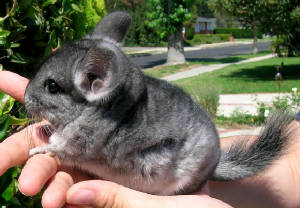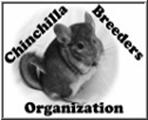Chinchillas under 6 months old require some special care and handling making them different from those that are older than 6 months. Some of the differences include feeding (including treats), playtime, exercise, bathing, taming and handling.
Feeding and Treats
Kits under 6 months of age are growing at a rapid rate. They need plenty of healthy calories to make sure that they grow to their potential. For this reason, all kits should be given round the clock access to a quality pelletted food and hay along with clean water. Never limit the amount of pellets and hay for a chinchilla kits. Always offer a quality, pellet only, feed. Never feed a mix of treats and pellets. Mixes are not good for chinchillas of any age. They will pick out the treats, which are not good for them, and not eat the pellets. Often, the pellets in the mixes are of poor quality. If kits do not receive proper nutrition, the results could be stunted growth, a shortened lifespan, and/poor health.
Treats of any kind should not be given to any kit under the age of 6 months. Kits have very tiny stomachs and it takes very little to fill them up. If their stomachs are filled with treats that have little or no nutritional value, there is little to no room for the healthy feed and hay. This can cause deficiencies in the nutrients that the kit needs to grow and be healthy. Often the effects of these deficiencies are not immediately visible, but rather take a few years to become apparent.
Playtime and Exercise

A four month old tan kit
The second serious problem with kits younger than 6 months of age and playtime is a rapid drop in blood sugar. This drop causes the chinchilla to experience seizures. Both seizures and heat stoke can be deadly and require the assistance of an exotics veterinarian for proper treatment.
Additionally, too much play and exercise can cause kits under 6 months to burn too many calories causing the chinchilla’s growth to be stunted. This happens when the chinchilla’s body has no more calories remaining from food that can be burned in the activity. Once this stage is reached, the chinchilla’s body begins to burn fat and then muscle when it runs out of fat. It is quite easy to see how this can lead to stunted growth and/or poor health.

Chinchilla kits taking a dust bath
Since kits under 6 months old are so cute and adventurous, they tend to be handled more often than older chinchillas. This can cause their fur to become greasy fairly rapidly. For this reason, it is often necessary to give kits a dust bath more often than an adult would need. A good rule of thumb is if the fur looks greasy or clumpy, it is time for a bath, regardless of when the last bath occurred.
Taming and Handling
With older chinchillas, it usually takes a few days to weeks, or even months, for them to become acclimated to a new home and to trust a new family. Taking things slowly is usually the best way to approach taming and handling a new, adult chinchilla. Young kits, however, are often less reserved and extremely curious. They may only take a few days, and in some case, hours to be ready to check out their new home. As long as a kit is not showing signs of fear, for example: hiding in the corner, crying, and/or running to hide when the cage is approached, it is acceptable to handle them. Always wait for the chinchilla to show that it is ready. Even kits that have been handled by their breeder from birth may need to take some time to get accustomed to their new family. The kit will show readiness by coming to the front of the cage to see you and climbing on hands or arms when they are placed in the cage. This is the sign to begin carefully picking up the kit. When the kit is climbing on your hands, carefully and slowly lift up. They may jump off and run the first few times. This is fine. Keep trying. Eventually, the kit will allow themselves to be picked up. Keep in mind that the more often a kit is handled, the sooner they will become tame.
When kits are more fearful or reserved, it is best to proceed slowly. Begin by giving the chinchilla a minimum of a couple of days alone in its cage to get used to its new surroundings. The cage should be placed in its permanent location so the kit can get used to the normal household smells and sounds. Only open the cage to feed and water the chinchilla. After a couple of days, time can be spent sitting next to the cage and talking to the kit. After a few days, a hand can be placed in the cage. Allow the chinchilla to approach the hand and inspect in its own time. Do not move the hand or arm and do not force the chinchilla or try to chase it around the cage. Once the kit is familiar with your hands and arms in the cage and is climbing all over them, it is time to start lifting them as mentioned above. Make sure the kit has a secure footing and slowly lift up while it is on your hands.

One way to properly hold a chinchilla kit.
Note that all four feet are supported



 Site Last Updated on December 31, 1969 05:00 pm
Site Last Updated on December 31, 1969 05:00 pm